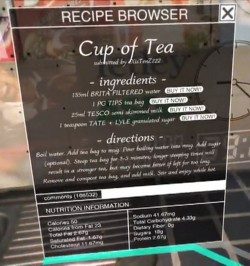I’d like to present two excellent AR concept videos which give a little glimpse into our world, not too far into the future, where AR is an integral part of life. Wearable computing and augmented reality are almost inevitable, but exactly how they’ll be utilized — for better or worse — is anyone’s guess. These two videos not only show realistic possibilities of advanced AR technology but also present smart commentary on the ramifications of such connected technology.
Augmented (hyper)Reality: Domestic Robocop
The first video is brief but ripe with social commentary. It was created by designer and filmmaker Keiichi Matsuda during his final year at University College London for a Masters in Architecture program. His description of the video:
The latter half of the 20th century saw the built environment merged with media space, and architecture taking on new roles related to branding, image and consumerism. Augmented reality may recontextualise the functions of consumerism and architecture, and change in the way in which we operate within it.
…part of a larger project about the social and architectural consequences of new media and augmented reality.

In the opening sequence we see an augmented reality world overrun by advertisements. With a gesture, the user turns down the ‘advertisement level’ so that they can actually see some of the physical world. If you look closely you can see that the advertisement level actually has rate/min value next to it; as the level is turned down, the money earned by the user per minute decreases. Perhaps in this vision of an AR world most consumers don’t even have jobs, they simply earn money by constantly seeing ads? Or maybe some people crank up the ad level to earn some change on the side. Whatever the case, the point is subtle but powerful — it is so believable given the present, which seems to be ever filling with ads.

After turning down the advertising level, the user goes to make a cup of tea. What seems like a simple task requires that the user look up a recipe and see step by step instructions. Sounds ridiculous, right? Only until you realize that such instructions are currently available online does the errie potential of such a scenario become apparent. The recipe also has handy ‘BUY IT NOW!’ links that pop up next to the ingredients list. Instead of a simple list, note that each product has a brand associate with it: Brita Filtered water, PG Tips tea bag, Tesco semi skimmed milk, Tate + Lyle granulated sugar — another subtle but excellent nod to this idea of advertising and consumerism gone wild.
As the kettle heats the water, another gesture takes the user away to a calm place where they can see social updates from friends. In the background, the tea kettle is still highlighted with a timer next to it. Micro updates and photos appear from friends in real time in this space. The user mustn’t stay long… they’re losing out on valuable ad-viewing money.
At least good music hasn’t gone out of style — a chiptune version of the Girl from Ipanema is heard playing in the background, probably through an ad-supported music player.
Sight
This is another video which is so excellent because it’s so plausible. Sight was created by Eran May-raz and Daniel Lazo as a graduation project from the Bezaleal Academy of Arts. This video is concerned about the gamification of life, among other things.
In the opening scene we see the protagonist doing an exercise on the floor. In his virtual reality world he’s actually playing a skydiving game, Sky Hero it seems to be called. As he roles over we see that his eyes are glowing with AR/VR contacts — this system is the namesake of the video, Sight. Once again, the parallel between this fictional world and real-life is quite stunning; take for instance the game Zombies, Run! which tries to gamify the simple exercise of running.
The user prepares a meal and is greeted with a sort of augmented reality version of Veggie Samurai. Straight cuts mean big points, but a bad slice frustrates him to the point of tossing the perfectly good cucumber to restart, presumably to get a better attempt at a high score.
A reminder of a date scheduled for later that night pops up. The user browses his closet contents from the comfort of his couch. Even his wardrobe isn’t safe from gamplay — in the background you see the fictional game My Closet, where he has a high score of 2945.As the user sits down to eat, his TV is projected onto the wall around him playing a sensationalized show about snails.
As the protagonist waits for his date we see him doing some star gazing. A relaxing moment away from a world clutter with augmented reality? No, just another game and a high score to go for — in fact, as his date disturbs his gameplay we can see that it wasn’t even a real sky he was looking at.

The date progresses and the two characters are plenty distracted by their own augmented realities. The protagonist fires up ‘Wingman’ — another game and advice app which will help him be the perfect date. He is struck by the fact that his date is vegatarian despite it not being in her ‘profile’. His surprise, and that the profile is unbranded, makes me think that this is a jab at the idea of Facebook (or some other social network) becoming an omnipotent social network where users are expected to disclose most of their personal info. In this world it would seem that not mentioning something important in your profile is a faux pas. Even more alarming for the woman is the prospect of her Sight system crashing; apparently about as bizarre as Facebook being down. She says “I didn’t see anything” implying that normal reality is nothing without being augmented.
As the pair return to his house, his date sees his customized AR home with virtual animated paintings and a wall full of achievements from all of his games, much like someone might have a trophy case. She spots something. On the wall of achievements, a single token lacks the ‘Perfect’ denotation. This catches her interest. As she focuses in she sees the description:
- “Wingman”
- App no: Unlisted
- Type: Social
- Price: N/A
- Status: Dev.
- Owner: Patrick. S
The perfect date – now within you reach! Utilizing advanced facial recognition and body language detection and intepretation algorithms, combined with our Sight-powered meta social database analyzer you can now be the person you walways wanted to be in any potentially romatic social interaction!
*Sight is not responsible and will not refund unsuccessful romantic endeavors.
Disgusted at the prospect of her date being a “game junkie”, apparently only on the date for the high score, she gets up to go. Then the rather fictitious part happens where she goes to leave but he accesses her Sight and controls her through it.
Aside from the control part at the end, this scenario seems genuinely plausible with the direction that technology is heading. Of course this is a rather dystopian view of where augmented reality might take us, but surely it could be used to constrict our lives just as much as it could be used to enhance them.
Is this really the direction we’re heading? One answer to that question might be to take a look at a concept video that Microsoft released in 2009. The video is a 10 year projection (2019) of how they see technology playing a role in our lives:
What do you think? Will advanced augmented reality ruin our lives or be useful and beneficial as a whole?







